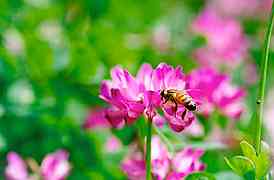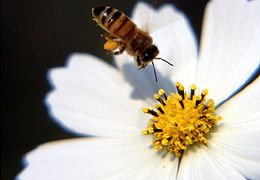
|
The Family Becomes Large in Spring. |
As spring flowers, including the pink clover flower, start blooming, worker bees fly around busily to collect honey and pollen. After visiting nearly 500 flowers, a worker bee brings back a half-body volume of honey and flies away looking for more honey. Worker bees go out to hunt for food more than 10 times a day if the weather is fine. The queen bee keeps laying worker bee eggs every day, so that the beehive's family members steadily increase.


|
The Old Queen Bee Leaves the Beehive in Early Summer. |
When the flowers of early summer, such as the acacia, horse chestnut, and ilex bloom, a lot of worker bees which were born in the spring mature, and prosperity comes to the beehive. Once the space for eggs becomes small, the queen bee starts to lay drone eggs followed by young queen bee candidates. After laying eggs for the next generation, the old queen bee leaves her beehive with half of her children. The new queen bee then goes out for a mating flight and returns to the beehive to lay eggs, which is, the biggest job of her life.


|
Drones Are Pushed out of the Beehive in the Fall. |
When the cool wind starts to blow, the number of flowers available to use in the making of honey decreases. If a long rain ensues, worker bees cannot go out. Worker bees collect the honey and pollen of tall goldenrod and tree resins for propolis, and store it in the beehive. In order to prepare for winter, when food becomes even more scarce, worker bees gradually make the queen bee lay fewer eggs, and drive the drones out of the beehive.


|
Bees Warm Each Other in Winter. |
When winter arrives, bees remain in the beehive. However,
they are not hibernating. The queen bee takes a rest from laying eggs
and stays in the center of a bee cluster, surrounded closely by worker
bees. Bees heat each other by flapping their wings, keeping the temperature
in the beehive at around 33°C. Stored honey is an important food for bees
during the winter.

|
Bees Sometimes Go Out in the Early Spring. |
It is still cold in the early spring, but worker bees begin to fly to spring flowers, such as the plum and veronica if it is sunny and warm enough. These worker bees were born before winter and spent it in the beehive, so it may be their first experience outside the beehive. When worker bees start to bring food back to the hive, the inside of the beehive becomes lively and the temperature goes up. When the warm season comes, the bees move around actively, and the queen bee starts laying eggs again. |

![]()



